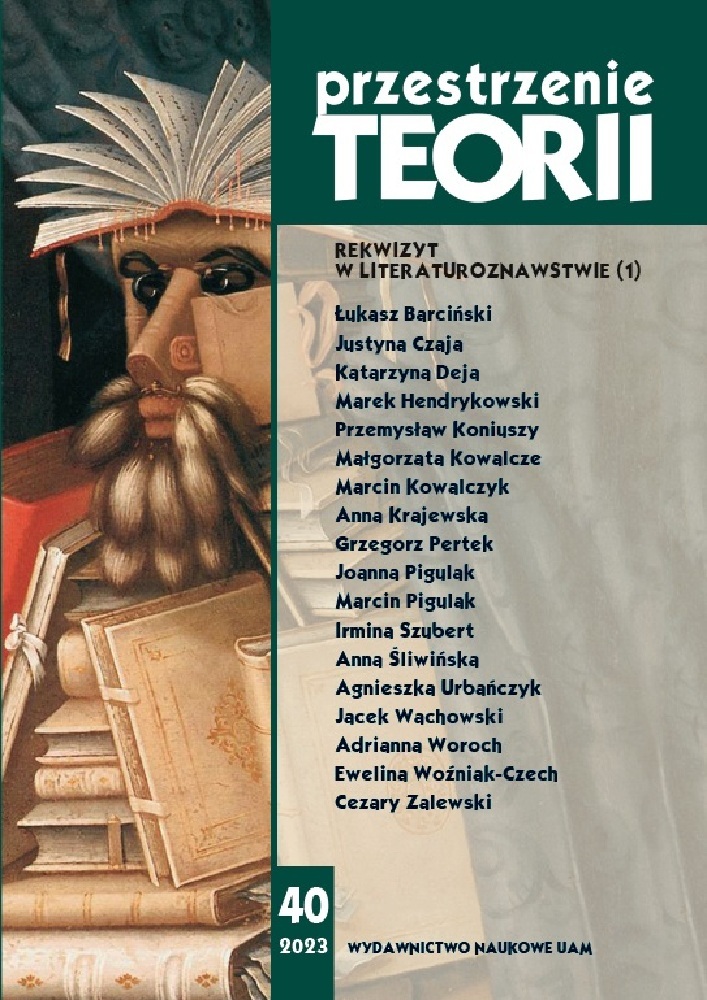Abstrakt
The paper discusses the letter exchange between Maria von Herbert and Immanuel Kant as an early example of fan mail. While the past research on Herbert described her as a sharp but underappreciated philosopher, in this paper she is treated primarily as a fangirl. The article discusses her correspondence with Kant (and Kant’s correspondence about her exchanged with others), her use of religious language as best means of conveying her fascination with an inaccessible celebrity, the parasocial interaction of these two, and the manner in which a hysterical discourse has been imposed on the young woman, not unlike the fate of contemporary fangirls.
Bibliografia
[autor nieznany], Novel Readers, [w:] American Tract Society, A Pastor’s Jottings, Or, Striking Scences During a Ministry of Thirty-five Years, New York 1864, s. 318–319.
Adorno Th.W., A social critique of radio music, [w:] Mass Communication and American Social Thought. Key Texts, 1919–1968, red. J. Durham Peters, P. Simonson, Lanham 2004, s. 211–214.
Aleksandrowicz A., Preromantyczne listowanie jako forma ekspresji uczuć, „Pamiętnik Literacki” 1993, nr 84, z. 2, s. 66–83.
Baker Th.N., Sentiment and Celebrity: Nathaniel Parker Willis and the Trials of Literary Fame, New York 1999. DOI: https://doi.org/10.1093/oso/9780195120738.001.0001
Bilkent Philosophy, Story Behind the Picture: Maria von Herbert, http://www.phil.bilkent.edu.tr/index.php/2018/12/15/story-behind-the-picture-maria-von-herbert/ (dostęp: 1.02.2023).
Coppa F., A Brief History of Media Fandom, [w:] Fan Fiction and Fan Communities in the Age of the Internet, red. K. Busse, K. Hellekson, Jefferson, NC 2006, s. 41–59.
Deleuze G., Guattari F., Co to jest filozofia?, przeł. P. Pieniążek, Gdańsk 2000.
Derecho A., Archontic Literature. A Definition, a History, and Several Theories of Fan Fiction, [w:] Fan Fiction and Fan Communities in the Age of the Internet, red. K. Busse, K. Hellekson, Jefferson, NC 2006, s. 61–78.
Eco U., Casablanca: Cult Movies and Intertextual Collage, [w:] Travels in Hyperreality, New York 1986, s. 197–212.
Foucault M., Historia seksualności, przeł. B. Banasiak, K. Matuszewski, T. Komendant, Warszawa 1995.
Gellert Ch.F., Listy Jmci Pana Gellerta, sławnego Akademii Lipskiey Professora z Niemieckiego na Polski Język przełożone, przeł. S.S., Wrocław 1814.
Hills M., Implicit Fandom in the Fields of Theatre, Art, and Literature, [w:] Studying „Fans” Beyond Fan Discourses, red. P. Booth, Boston 2018, s. 477–494. DOI: https://doi.org/10.1002/9781119237211.ch30
Horton D., Wohl R., Komunikacja masowa i paraspołeczna interakcja. Uwagi o intymności na odległość, przeł. A. Piskorz, [w:] Pejzaże audiowizualne. Telewizja, wideo, komputer, red. A. Gwóźdź, Kraków 1997, s. 63–90.
Jenkins H., Textual Poachers: Television Fans and Participatory Culture, New York 1992.
Kant I., Korespondencja, red. M. Żelazny, M. Chojnacka, przeł. M. Żelazny, Toruń 2018, s. 380.
Know Your Meme, Your Music Saved Me, https://knowyourmeme.com/memes/your-music-saved-me (dostęp: 29.12.2022).
Knox R.A., Studies in the Literature of Sherlock Holmes, http://www.diogenes-club.com/studies.htm (dostęp: 29.12.2022).
Kobus A., Fandom. Fanowskie modele odbioru, Toruń 2018.
Laken A.R., Parasocial relationships with celebrities: An illusion of intimacy with mediated friends, UNLV Theses, Dissertations, Professional Papers, and Capstones, http://dx.doi.org/10.34917/2307944 (dostęp: 29.12.2022).
Langton R., Duty and Desolation, „Philosophy” 1992, vol. 67, no. 262, s. 481–505. DOI: https://doi.org/10.1017/S0031819100040675
Langton R., Seksualny solipsyzm, przeł. M. Musiał, „Analiza i Egzystencja” 2015, nr 30, s. 5–59.
Mahon J.E., Kant and Maria Von Herbert: Reticence vs. Deception, „Philosophy” 2006, vol. 81, no. 317, s. 417–444. DOI: https://doi.org/10.1017/S0031819106317020
Matuszewska P., Pod hasłem naturalności: o listowniku Stanisława Szymańskiego, „Pamiętnik Literacki” 1977, nr 68, z. 2, s. 83–110.
Mole T., Byron’s Romantic Celebrity: Industrial Culture and the Hermeneutic of Intimacy, New York 2007. DOI: https://doi.org/10.1057/9780230288386
Redmann J., Else Lasker-Schüler: Writing Hysteria, „Women in German Yearbook” 2002, vol. 18, s. 202–224. DOI: https://doi.org/10.1353/wgy.2002.0015
Ritter B., Solace or Counsel for Death: Kant and Maria von Herbert, [w:] Women and Philosophy in Eighteenth-Century Germany, red. C. Dyck, Oxford 2021. DOI: https://doi.org/10.1093/oso/9780198843894.003.0008
Ritter B., szkic artykułu Solace or Counsel for Death udostępniony na profilu autora na Academia.edu, https://www.academia.edu/38105739/Solace_or_counsel_for_death_Kant_and_Maria_von_Herbert_OUP_2021_ (dostęp: 21.12.2021).
Ryan B., One Reader, Two Votes: Retooling Fan Mail Scholarship, [w:] The History of Reading, vol. 3. Methods, Strategies, Tactics, red. R. Crone, Sh. Towheed, London 2011, s. 66–79. DOI: https://doi.org/10.1057/9780230316737_5
Rybicka E., Antropologiczne i komunikacyjne aspekty dyskursu epistolograficznego, „Teksty Drugie” 2004, nr 4, s. 40–55.
Sairio A., Nevala M., Social dimensions of layout in eighteenth-century letters and letter-writing manuals, „VARENG” 2013, vol. 14. Principles and Practices for the Digital Editing and Annotation of Diachronic Data, http://www.helsinki.fi/varieng/journal/volumes/14/sairio_nevala/ (dostęp: 29.12.2022).
Spiro Lsa, Reading with a tender rapture: Reveries of a Bachelor and the rhetoric of detached intimacy, „Book History” 2003, no. 6, s. 57–93. DOI: https://doi.org/10.1353/bh.2004.0013
Stanfill M., Exploiting Fandom. Fandom. How the Media Industry Seeks to Manipulate Fans, Iowa 2019. DOI: https://doi.org/10.1353/book64197
TV Tropes, Word of God, https://tvtropes.org/pmwiki/pmwiki.php/Main/WordOfGod (dostęp: 29.12.2022).
Licencja
Prawa autorskie (c) 2023 Agnieszka Urbańczyk

Utwór dostępny jest na licencji Creative Commons Uznanie autorstwa – Użycie niekomercyjne – Bez utworów zależnych 4.0 Międzynarodowe.
Autorzy
Autorzy tekstów przyjętych do publikacji w czasopiśmie „Przestrzeniach Teorii” są zobowiązani do wypełnienia, podpisania i odesłania na adres redakcji umowy o udzielenie nieodpłatnej licencji do utworów, z zobowiązaniem do udzielania sublicencji CC.
Zgodnie z umową, autorzy tekstów opublikowanych w czasopiśmie „Przestrzeniach Teorii” udzielają Uniwersytetowi im. Adama Mickiewicza w Poznaniu niewyłącznej i nieodpłatnej licencji oraz zezwalą na użycie sublicencji Creative Commons Attribution-NonCommercial-NoDerivatives 4.0 International (CC BY-NC-ND 4.0).
Autorzy zachowują prawa do dalszego, swobodnego rozporządzania utworem.
Autorzy, którzy wykorzystują w swoim tekście cudze utwory (np. ilustracje, fotografie) proszeni są o dostarczenie do redakcji czasopisma zgodę na publikację od uprawnionych podmiotów.
Użytkownicy
Zainteresowani użytkownicy internetu uprawnieni są do korzystania z utworów opublikowanych po 2015 roku „Przestrzeniach Teorii” tylko w calach niekomercyjnych, pod następującymi warunkami:
- uznanie autorstwa - obowiązek podania wraz z rozpowszechnionym utworem, informacji, o autorstwie, tytule, źródle (odnośniki do oryginalnego utworu, DOI) oraz samej licencji;
- bez tworzenia utworów zależnych - utwór musi być zachowany w oryginalnej postaci, nie można bez zgody twórcy rozpowszechniać np. tłumaczeń, opracowań.
Do wszystkich tekstów opublikowanych przed 2015 r. prawa autorskie są zastrzeżone.
Inne
Uniwersytet im. Adama Mickiewicza w Poznaniu zachowuje prawo do czasopisma jako całości (układ, forma graficzna, tytuł, projekt okładki, logo itp.).

